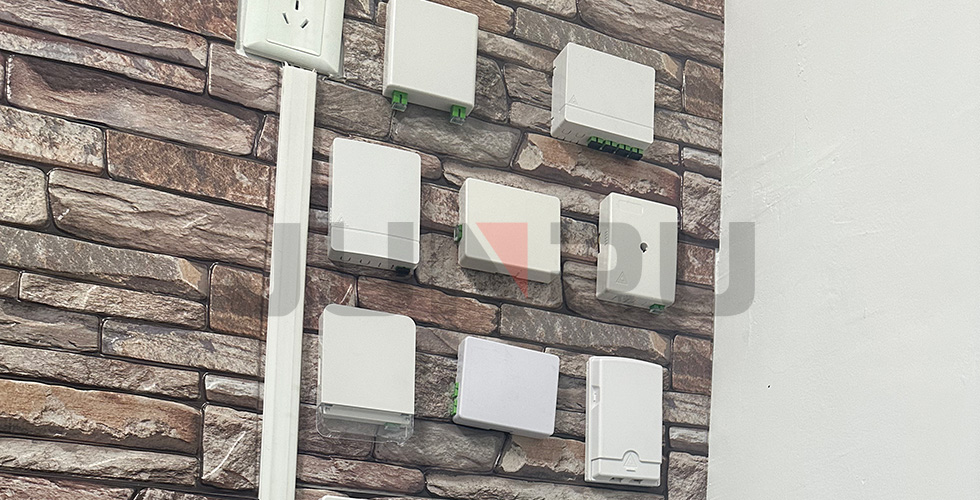

FRB-2B-1 fiber rosette box is able to hold up to 2 subscribers. It is used as a termination point for the drop cable to connect with patch cable in FTTH indoor application. It integrates fiber splicing, termination, storage and cable connection in one solid protection box.
A Fiber Cable Termination Box, also known as a fiber optic termination box or enclosure, is a crucial component in fiber optic networks and can be used for various purposes. Here are five common uses:
Connecting Subscriber Lines: Fiber cable termination boxes are often used in Fiber-to-the-Home (FTTH) or Fiber-to-the-Business (FTTB) installations. They serve as the point of connection between the service provider's fiber optic cable and the subscriber's premises, enabling high-speed internet, TV, and phone services.
Distribution and Splitting: These boxes are used for distributing and splitting optical signals to multiple endpoints within a network. They can house splitters and adapters, allowing one input fiber to be split into multiple output fibers for various applications.
Fiber Splicing: Fiber termination boxes provide a secure and protected environment for splicing fiber optic cables. Technicians can splice or connect individual fibers within the box, ensuring a reliable and low-loss connection between optical cables.
Protection and Organization: They are used to protect delicate fiber optic connectors, adapters, and splice points from environmental factors such as dust, moisture, and physical damage. Additionally, termination boxes help organize and manage fiber optic cables, ensuring neat and efficient cable routing.
Network Expansion and Maintenance: Fiber cable termination boxes are essential for network expansion and maintenance activities. They allow for easy access to fiber connections and components, simplifying the process of adding new subscribers, troubleshooting issues, or making repairs within the network.
Protection of Fiber Connections: Fiber cable termination boxes provide a secure and protected environment for fiber optic connections, connectors, and splice points. They shield delicate components from harsh environmental conditions, such as moisture, dust, and temperature extremes, ensuring the longevity and reliability of the network.
Organized Cable Management: These boxes offer a structured and organized means of managing fiber optic cables. They come with cable routing guides, trays, and ports that help prevent cable tangling, clutter, and damage. Proper cable management simplifies maintenance, troubleshooting, and future expansions of the network.
Ease of Installation and Maintenance: Fiber cable termination boxes are designed with ease of installation and maintenance in mind. They often feature user-friendly designs, secure locking mechanisms, and removable panels or trays, making it convenient for technicians to access and work on fiber connections. This reduces downtime during maintenance or repairs.
Scalability and Flexibility: Fiber termination boxes come in various sizes and configurations to accommodate different network requirements. They can be used in a wide range of applications, from FTTH deployments to data center connections. Their scalability allows for network expansion and adaptability to evolving technology needs.
In summary, choosing a Fiber Cable Termination Box enhances network reliability, simplifies cable management, reduces installation and maintenance complexities, and offers flexibility for various network applications. These advantages make them an essential component in fiber optic network deployments.

An optical terminal box, also known as an optical distribution box or fiber termination box, is a device used in fiber optic communication networks to terminate and distribute optical fibers. It serves as a central point for connecting incoming and outgoing fiber optic cables, as well as providing protection and organization for fiber optic splices and connectors.
The main functions of an optical terminal box include:
Fiber termination: The optical terminal box provides a termination point for incoming and outgoing fiber optic cables, allowing for the connection of multiple fibers in a neat and organized manner.
Fiber splicing: It provides a space for splicing or connecting individual fiber optic cables together, ensuring a secure and reliable connection for data transmission.
Cable management: The optical terminal box helps to manage and organize fiber optic cables, reducing the risk of cable damage and improving overall network performance.
Protection: It protects fiber optic splices, connectors, and cables from environmental factors such as dust, moisture, and physical damage.
An optical terminal box plays a crucial role in fiber optic communication networks by providing a centralized and secure location for terminating, splicing, and distributing fiber optic cables, ensuring efficient and reliable data transmission.
 Call us on:
Call us on:  Email Us:
Email Us:  Wanhua Science and Technology Park, No. 528, Shunfeng Road, Donghu Street, Linping District, Hangzhou City, Zhejiang Province
Wanhua Science and Technology Park, No. 528, Shunfeng Road, Donghu Street, Linping District, Hangzhou City, Zhejiang Province